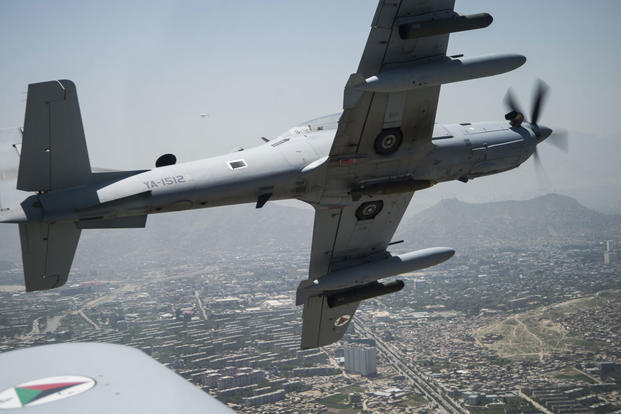An A-29B Super Tucano attack aircraft slated for the Afghan air force crashed in a residential area outside Moody Air Force Base on Monday, but neither the pilots nor residents on the ground were injured, the U.S. Air Force said.
Two pilots from the 81st Fighter Squadron -- who weren't identified and whose nationalities weren't released -- ejected from the turboprop aircraft during a routine training flight around 2:50 p.m. near Homerville, Georgia, the service said in a statement late Monday.
While the aircraft crashed into a residential area, it didn't strike any structures, a spokesman at the base told Military.com on Tuesday morning. Both pilots were taken to the nearby Clinch Memorial Hospital for evaluation and were released, according to the statement.
The U.S. Air Force will investigate the cause of the mishap and release the findings at a later date, the service said.
As of last month, the Afghan air force had trained about 20 pilots to fly eight of the Super Tucanos. The training takes place at Moody.
A U.S.-funded $427 million contract calls for a total of 20 A-29s made by the Brazilian firm Embraer S.A. in partnership with the U.S.-based Sierra Nevada Corp. to be delivered to Afghanistan by 2018.
The A-29s, designed for close-air support, carry a 20mm cannon below the fuselage and one 12.7mm machine gun under each wing, and can also fire 70mm rockets and launch precision-guided bombs.
The Afghans have flown several hundred missions since the aircraft became operational in April 2016, though they're reportedly dropping munitions at a far higher rate than U.S. pilots at a time when civilian casualties from airstrikes are mounting.
The Military Times newspapers in 2016 reported 138 A-29 missions out of a total of 328, or 43 percent, involved firing or the dropping of munitions, while U.S. aircraft had a drop rate of about 12 percent.
Meanwhile, the U.N. Assistance Mission in Afghanistan, or UNAMA, released a report in Kabul on Feb. 7 stating that in 2016, "Airstrikes carried out by Afghan and international forces caused 590 civilian casualties (250 deaths and 340 injured), nearly double that recorded in 2015 and the highest since 2009."
-- Richard Sisk contributed to this report.
-- Brendan McGarry can be reached at brendan.mcgarry@military.com. Follow him on Twitter at @Brendan_McGarry.
Related Video:
The A-29 Super Tucano





























